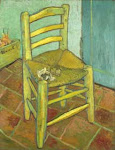
Visitors to the Museo Archeologico in Florence -- in my opinion one of the most overlooked and underrated museums in Europe -- will for the next six months miss one of its treasures: the spectacular Chimaera of Arezzo, an Etruscan sculpture from around the early 4th century B.C. The Chimaera is off to the Getty Villa in Malibu for a chimaera-themed exhibition from 16 July through 8 February, starring among other artistic representations of the ancient monster and its conqueror, the Greek hero Bellerophon. The "Chimaera of Arezzo" show is the first in a series of planned collaborations between the Getty and the Museo Archeologico di Firenze; it's no secret (I don't think) that the Chimaera and other long-term loans are part of the deal worked out between the Getty and the Italian government, when the museum agreed to return close to forty ancient objects on suspicion that they were looted.
I have a mental list of the top ten artworks I would happily install in my home if given the opportunity, and the Chimaera of Arezzo is one of 'em. He is a beautiful thing. Photographs do not capture his elegant lines or the luster of his bronze surface, the ferocity of his snarl, the arrested power of his pose. Unfortunately his installation in the Museo Archeologico is less than flattering; at least in 2004, he was perched on a pedestal seemingly stuck in the center of a corridor, no real room to step back and admire him as he deserves. I hope while he is in Malibu his owners are making him a new home.
In antiquity the Chimaera was a dedication to the Etruscan equivalent of Zeus, placed in a sanctuary. We know this from the inscription on his right foreleg: TINSCVIL, or gift to Tinia. He was discovered in Arezzo in the mid-16th century, and when word of his beauty reached Florence, none other than Cosimo de'Medici, Grand Duke of Tuscany, made it his business to acquire the statue. But at first everyone thought the Chimaera was a lion -- his snaky tail was missing when first discovered. Renaissance-era artist and historian Giorgio Vasari tells us that fragments of the tail were later recovered and the Chimaera's true identity revealed; however, the tail itself was not restored until the 18th century. Earlier restorations done soon after the Chimaera first came to Florence are said to have been done by renowned sculptor Benvenuto Cellini, including perhaps part of the left foreleg.
Some scholars wonder if the Chimaera was originally part of a group sculpture which included Bellerophon vanquishing the beast -- he would therefore be snarling at a specific figure and aiming to pounce. But I don't think the Chimaera needs another figure. Certainly in antiquity everyone would know the myth, and without a second statue, the viewer him/herself "becomes" Bellerophon and faces the monster. To me that is the emotional impact of encountering this statue, having it threaten YOU.
Admission to the Getty Villa (not be confused with the Getty Center in Los Angeles) is free but requires an advance, timed ticket. See the Getty website for more information about the Chimaera of Arezzo exhibition and how to visit.






No comments:
Post a Comment